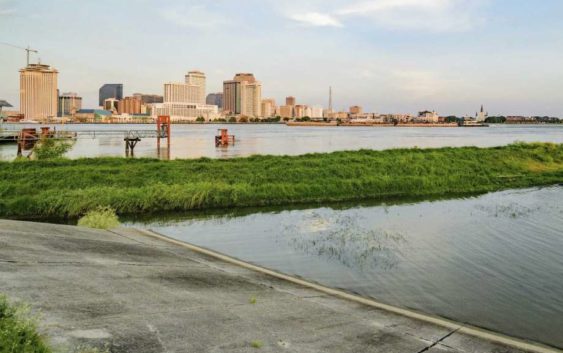- South Carolina's governor declares State of Emergency as massive wildfire grows to 1,600 acres
- Staying weather alert: How to find your safe place during severe weather
- Wildfires persist across Carolinas amid windy, dry conditions
- York County crews help battle South Carolina wildfires
- Crews battle wildfires in North and South Carolina amid dry conditions and gusty winds
Tropical Storm Barry threatens a long, slow drenching

NEW ORLEANS (AP) — Building toward hurricane strength, Tropical Storm Barry began hitting Louisiana with wind and rain Friday as it closed in for what forecasters said will be a long, slow — and epic — drenching that could trigger flooding in and around New Orleans.
With the storm expected to blow ashore by early Saturday, National Guard troops and rescue crews were stationed around the state with boats and high-water vehicles, helicopters were on standby, drinking water and blankets were made ready for distribution, and utility crews with bucket trucks moved into the region.
-
The Mississippi River approaches a levee at left in New Orleans, La., Thursday, July 11, 2019, ahead of Tropical Storm Barry. Never in the modern history of New Orleans has water from the Mississippi River overtopped the city’s levees. lessThe Mississippi River approaches a levee at left in New Orleans, La., Thursday, July 11, 2019, ahead of Tropical Storm Barry. Never in the modern history of New Orleans has water from the Mississippi River … more
Photo: Matthew Hinton, AP
Photo: Matthew Hinton, AP
National Hurricane Center Director Ken Graham said pockets of Louisiana could get as much as 25 inches (63 centimeters) of rain.
Graham said that Barry had a “small chance, maybe” of becoming the first hurricane of the Atlantic season as it comes ashore, but added: “That’s not the point here.” The real danger, he said, is not the wind but the rain.
The storm could give New Orleans its worst drenching in decades, possibly eclipsing the city’s wettest day on record — 12.24 inches (32 centimeters)— on May 8, 1995, forecasters said. It could also shatter Baton Rouge’s one-day record rainfall of 11.99 inches (30 centimeters) from April 14, 1967.
The downpours are expected to pose a severe test of the improvements made in New Orleans’ flood defenses since the city was devastated by Hurricane Katrina in 2005.
The Mississippi River is already running abnormally high because of heavy spring rains and snowmelt upstream, and the ground around New Orleans is soggy because of an 8-inch drenching on Wednesday.
“There are three ways that Louisiana can flood: storm surge, high rivers and rain,” Louisiana Gov. John Bel Edwards said. “We’re going to have all three.”
Edwards said on Thursday that that authorities do not expect the river to spill over its levees, but cautioned that a change in the storm’s direction or intensity could alter that.
President Donald Trump declared a federal emergency for Louisiana, authorizing the Department of Homeland Security and the Federal Emergency Management Agency to coordinate relief efforts.
As of Friday morning, Barry was about 95 miles (155 kilometers) southwest of the mouth of the Mississippi, with winds around 50 mph (80 kph), well short of the 74 mph (119 kph) hurricane threshold.
Tracking forecasts showed the brunt of the storm blowing into the Louisiana delta west of New Orleans on a path that could continue toward Chicago, swelling the Mississippi River basin with water that must eventually flow south again.
About 10,000 people in Plaquemines Parish on Louisiana’s low-lying southeastern tip were ordered evacuated on Thursday.
Among the last to leave were 65-year-old Clarence Brocks and his family. The Plaquemines Parish native evacuated many times before and had to rebuild after Katrina wiped out his home. But he said he wouldn’t want to live anywhere else.
“I was born and raised here. This is all I know,” the Air Force veteran said. “I’ve been all over the world and guess where I want to be at? Right here.”
With lightning flashing in the distance and some streets already covered with water from heavy rains, shoppers at an Albertsons grocery store in Baton Rouge stripped shelves bare of bread. Half the bottled water was gone.
Meanwhile, utility crews with bucket trucks that could be needed after the storm filled hotel parking lots along Interstate 59 in southern Mississippi.
New Orleans Mayor LaToya Cantrell said Thursday that the pumping system that drains the city’s streets was working as designed after the rain and flash floods earlier this week but that Barry could dump water faster than the pumps can move it.
“We cannot pump our way out of the water levels … that are expected to hit the city of New Orleans,” she warned.
However, the city did not plan to order evacuations because Barry was so close and because it was not expected to grow into a major hurricane. Officials instead advised people to keep at least three days of supplies on hand and to keep their neighborhood storm drains clear so water can move quickly.
Hurricane Katrina caused catastrophic flooding in New Orleans 14 years ago and was blamed altogether for more than 1,800 deaths in Louisiana and other states, by some estimates.
In its aftermath, the Army Corps of Engineers began a multibillion-dollar hurricane-protection system that isn’t complete. The work included repairs and improvements to some 350 miles (560 kilometers) of levees and more than 70 pump stations that are used to remove floodwaters.
___
Contributing to this report were Associated Press reporters Chevel Johnson and Rebecca Santana in New Orleans; Sarah Blake Morgan in Plaquemines Parish; Jay Reeves in Baton Rouge; and Jonathan Drew in Raleigh, North Carolina.